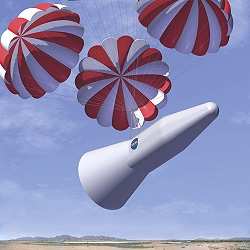Could Be First New Escape System Since Apollo
 NASA has tested rocket engines and
parachutes that could be instrumental in developing the first
spacecraft crew launch escape system in almost 30 years.
NASA has tested rocket engines and
parachutes that could be instrumental in developing the first
spacecraft crew launch escape system in almost 30 years.
The tests pave the way for a series of integrated Pad Abort
Demonstration (PAD) test flights to support NASA's Orbital Space
Plane (OSP) program. Launch pad abort tests support development of
a system that could pull a crew safely away from danger during
liftoff. Knowledge gained from the testing will reduce the future
design and development risks of a launch escape system that could
be used for the OSP.
"PAD is the first launch pad crew escape system NASA has
developed since Apollo," said Chuck Shaw, PAD Project Manager at
the Johnson Space Center (JSC) in Houston (TX). "The engine and
parachute tests followed successful vehicle wind tunnel tests in
September."
The engines were fired in tests at the Marshall Space Flight
Center (MSFC) in Huntsville, Ala., in November and December. A
series of 14 hot-fire tests of a 50,000-pound thrust RS-88 rocket
engine were conducted, resulting in a total of 55 seconds of
successful engine operation. The final test was completed Dec. 11.
The engine is being designed and built by the Rocketdyne Propulsion
& Power unit of The Boeing Company.
The parachutes were tested at the Army's Yuma Proving Grounds in
Yuma (AZ) Dec. 9. The tests verified the function, performance and
stability of an 80-foot drogue parachute and four 156-foot main
parachutes. A 12.5-ton pallet, simulating the size and weight of a
crewed vehicle, was dropped from 10,000 feet. The pallet descended
to a soft landing under almost two acres of parachutes. A second
set of parachute tests will be conducted at Yuma in spring
2004.
Integrated launch abort demonstration tests in 2005 will use
four RS-88 engines to separate a test vehicle from a test platform,
simulating pulling a crewed vehicle away from an aborted launch.
Four 156-foot parachutes will deploy and carry the vehicle to
landing. Lockheed Martin Corporation is building the vehicle for
the PAD tests. "The separate subsystem tests will allow NASA and
Lockheed Martin to begin integration of the test vehicle, its
engines and parachutes over the next year," Shaw said.
Seven integrated PAD test flights are planned during 2005/06.
For the initial PAD flight test in mid-2005, a representative crew
escape module will be mounted on a pusher propulsion module.
Instrumented mannequins will represent a spacecraft crew during the
tests.

NASA awarded a contract to Lockheed Martin in November 2002, to
design and build a crew escape and survivability system
demonstrator and to establish a flexible test bed for use in
support of the OSP program.
The OSP program will support US International Space Station
requirements for crew transport, rescue and contingency cargo. The
OSP will initially launch on an expendable vehicle and provide
rescue capability for at least four crewmembers. OSP could launch
as early as 2008. Crew transfer for the Station is planned as soon
as practical, but no later than 2012.
 ANN's Daily Aero-Term (04.26.24): DETRESFA (Distress Phrase)
ANN's Daily Aero-Term (04.26.24): DETRESFA (Distress Phrase) Aero-News: Quote of the Day (04.26.24)
Aero-News: Quote of the Day (04.26.24) ANN's Daily Aero-Term (04.27.24): Direct
ANN's Daily Aero-Term (04.27.24): Direct ANN's Daily Aero-Linx (04.27.24)
ANN's Daily Aero-Linx (04.27.24) Aero-News: Quote of the Day (04.27.24)
Aero-News: Quote of the Day (04.27.24)




